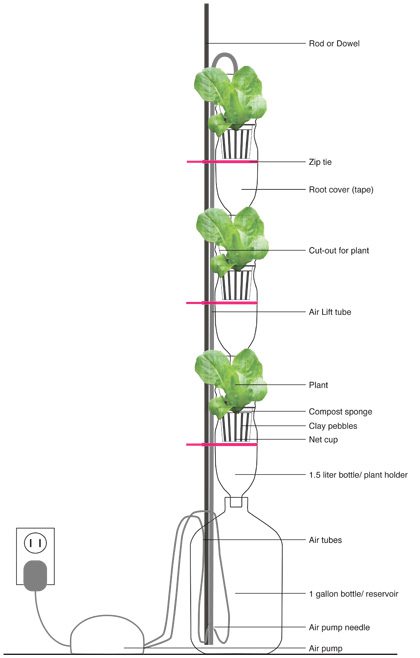Unlike the tiny confines of a window sill garden, window farms seek to make more efficient use of all that natural sunlight just inside the glass. It’s a linear greenhouse arrangement that you could refer to as vertical gardening. This is an especially enticing approach to indoor gardening for apartment dwellers whose available floor and counter space are highly limited, and it allows growing food and ornamental plants, both year-round and during the colder months between late autumn and spring.
The first window farm was made from repurposed 2-liter drink bottles back in 2009 taking advantage of huge old windows in a New York City apartment. Introducing people to their concept after arriving at a working design with the initial kinks corrected, artists Britta Riley and Rebecca Bray built a window gardening community with 15,000 people around the globe building their own systems, sharing ideas and crop notes, all while improving the original concept. What began as a drip irrigated garden arranged in vertical columns morphed into an actual recirculating hydroponic style, making great use of recycled materials available anywhere.
That collaborative effort led to both partial and complete kits being sold by WindowFarms.org in 2010. By 2011, Riley turned to Kickstarter to gather funding to take the perfected system window farms with polished aesthetic appeal into production. Though raising far more than requested and some angel investor capital raised in 2013, only US crowd funders received all rewards, with some Canadians and all off-continent international early adopters still empty-handed in late 2014. No refunds were given, and in the ensuing scandal, the Windowfarms website disappeared – along with all the knowledge and information collected in the growers’ community forums.
Thankfully, enough information and how-tos exist online that it’s still possible to build your own window farms. However, like any other way one can grow plants, it has its limitations.

Window Farm Lighting
Unfortunately, unless you’ve got a south-facing window without any obstructions that can interrupt sun from dawn to dusk, window farms aren’t likely to produce scads of food. Even with full southern exposure, shorter days and cloudy skies of winter can reduce plant vigor quite a bit without supplemental grow lighting. So, plan on adding at least LED strip lights to illuminate as much of the plants’ four sides as possible. Remember, the room side of whatever you’re growing will get no light at all, and the sides will only get half a day’s sunshine.
Doing some image research, you’ll find that they were using suspended compact CFL bulb clusters between the columns. Technology has given you better choices today at far less cost than a few years ago! You’ll get more food out of your window garden with good lighting on all sides for at least 12-14 hours a day.
Be sure to note that good fruiting calls for red spectrum lights, while greens and herbs do better under blue spectrum, and both do fine with full spectrum white LEDs.

Irrigating Window Farms
You can’t use recirculating hydroponics if you choose a potting mix as the growth media. It will plug up plumbing and pumps, and drain-to-waste isn’t very wise freshwater or nutrient use. Planting in clay pellets allows recirculating nutrient-rich water from the bottom reservoir to the top planter as is shown in this diagram to the right. The water then moves through each plant’s root system until draining back into the reservoir.
There are two ways of setting up the water system for window farms; several columns of plants with a single reservoir, and each column having its own smaller tank. The second requires more pumps, but allows you to grow more varied crops, because building lots of leaves or roots compared to creating blooms and fruits need different nutrient formulas.
Growth Rate and Temperature
This is a major limitation of window farms. The outdoor temperature will affect your plants’ environment just inside the glass. Even new thermal pane windows radiate heat and cold, and the best-insulated window framing cannot fully eradicate temperature swings. So, your plants will exhibit the effects of hot days that change to cool nights, and frigid nights following cold days. These environments are known to slow and retard growth, especially warmth-loving crops like tomatoes and peppers.
But it’s a limitation that you can work around by planting cool-season crops in winter, and perhaps growing extra plants during a crop’s slow season. Good space planning and plant selection will help window farms produce more.
One thing that might help your plants grow better in a frigid Northern winter is sealing the window with an insulation film to block as much of the radical temperature fluctuation as possible between the glass and the outer edge of the window molding – at least during the cold months.
What Can You Grow?
Short, bushy plants suit this system best. You can try compact patio tomatoes, peppers, and chilies, but might find that these are best grown in the long days of summer for increased fruiting. Day-neutral strawberries (everbearing) could prove a great choice, along with leafy greens, lettuces, and herbs. Be a little adventurous, just avoid huge and vining plants.
Learn more:
- Authentic DIY Directions (download – comment 4)
- Farmit version DIY
- WindowFarms Kickstarter Scandal
- Kickstarter comments 2014
- The Original Kits
Images courtesy of Victorgrigas, Hendy Curzon, and yuyoschubutenses (respectively).